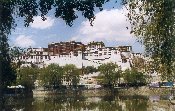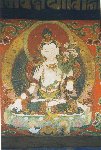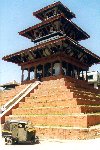 |
A city of huge buildings, lots of traffic and many mansions where you can find a room to sleep. We had a room, conveniently located behind Nathan Road, i.e. Rent-A-Room, 7-8 Tak Hing Street, Flat A, 2/F, Knight Garden, Kowloon.
Hong Kong island is one of the city's main attractions with its Peak, Star ferries, escalator alley and old trams. |
 |
Chengdu is an important entry point if you like to go to Tibet Autonomous Region (Tibet). The Traffic hotel can arrange trips, but we arranged it already in the Netherlands. You need a special permit to enter Tibet, apart from a visa to enter China.
Chengdu is famous for the Sichuan food and the panda bears. You will find a couple of them in the zoo, where you can also find the very old (7th century) Zhaojue-temple. Don't forget to look at the old wooden roofs of the houses in the city centre.
 |
Lhasa is the capital of Tibet and has many beautiful buildings, like the Potala palace,
 |
 |
 |
 |
 |
 |
The Jokhang temple is for Tibetans the most important temple, even
more important than the Potala palace, where the Dalai Lama used to live.
Around the Potala palace many prayer wheels are turned around all day.
 |
 |
 |
 |
Sera and Drepung are two monasteries not to be missed. In Sera every day at 15.30 hours monks come together for praying and debating. Drepung monastery is situated at a steep hill. Try to find bus number 4 that brings you all the way up to the entrance.
 |
 |
 |
We arranged through Shigatse Travels, at the Yak hotel, a seven day trip to the Nepalese border. A good travel agency with nice guides and drivers.
It was a wonderful trip. The landscape in Tibet is barren. Yaks and sheep are the main animals. The roads, even the Friendship Highway, are terribly dusty and bumpy, but the views are magnificent. The trip is a not to be missed experience; not cheap, but worth every yuan.
 |
 |
 |
The tour brought us over Kamba La, at about 4,950 m, along the turquoise Yamdrok-Tso lake first to Nagartse and from there over a 5,200 m pass to Gyantse.
Gyantse's main attractions are the Pelkor stupa and Kumbum monastery. According to our guide Kumbum is the name of the monastery, not of the stupa, though some guide books refer differently. The stupa has four floors with about 80 chapels in which you will find many beautiful murals.
Gyantse itself is a small village with only two main roads, though the area is huge. If you spend a night in Gyantse, don't expect too much of the hostels; they are mainly very basic and not always very clean. But it is certainly worth the "trouble" to stay there overnight.
 |
 |
 |
 |
Shigatse is the second largest town in Tibet. It has a modern, Chinese
part and a lovely Tibetan quarter. You can easily spend a full day here,
walking around and visiting the famous Tashilhunpo monastery, seat of the
Panchen Lama and of the very large Maitreya, the Future Buddha.
The market across the Tenzin hotel is nice and just around the corner
you can find some nice restaurants. After having tried some Tibetan restaurants,
we preferred the Chinese ones :-)
 |
 |
 |
Our next stop was Sakya, a very Tibetan village. Unlike the whitewashed
houses in other parts of Tibet, Sakya buildings are grey with white and
red vertical stripes.
The Sakya monastery, main seat of the Kagyupa order, has very
thick walls and has the largest Buddhist library in the world.
You can spend the night in Sakya, but Lhatse, only one hour driving
away, offers as a main truck stop a bit more comfort.
 |
 |
 |
If you intend to drive to Rongbuk and Mount Everest base camp, be careful; the required extra permit for the Mount Everest base camp has to be picked up at the PSB in Shegar (at least when we were there) and not half an hour driving further in the tiny village on the road to the camp. There is another checkpoint, but they did not issue the permits anymore. But this can change again, but check in advance. Otherwise it costs you one hour to go back and forth.
The road to the base camp is even worse than the other roads, but again, the views can be magnificent. If the weather is clear, you will have great views of the Mount Everest.
You can try to sleep at Rongbuk monastery at 5,500 metres or, if
you brought a tent, at the base camp at 5,200 metres, but we spent the
night in a little village Tashi Dzom, at "only" 4,000 metres. Very basic,
but at least we had no sleeping problems.
 |
 |
 |
 |
 |
There is only one way to the base camp, so you have to drive the
same way back over again a 5,200 metres pass to the Friendship Highway.
The last 5,000 metres pass before the Nepal border gives very fine
views over the Xixabangma mountains. From there the road only goes down
and at 30 km before the border you will find a little village, Nyalam,
where you can spend the last night before crossing the Friendship bridge
to Nepal.
Zhangmu is the Chinese border town and from there the road continues for ten km through no-man's land and leads down to the Nepalese border town Kodari at the other side of the Friendship bridge. Try to arrange that your landcruiser brings you to the bridge, since the road is very bad and narrow with a lot of traffic. Walking these ten km with your backpack is no fun.
 |
Nepal
From Kodari it takes about 4 to 5 hours by bus to Kathmandu, the capital of Nepal. A nice hotel, centrally located in Chetrapati near Thamel, is hotel Ganesh Himal.
A famous place in Kathmandu is Durbar square with the old palace, the Kumari palace and many other temples. Here you will see a lot of sadhus, holy men (or just beggars?). The Swayambunath stupa, the mini Swayambunath stupa, the large stupa at Bodnath and Pashupatinath temple with its ghats are other places of interest. It is a very nice walk from Bodnath to Pashupatinath (see Lonely Planet travel survival guide).
 |
 |
 |
 |
 |
 |
 |
 |
 |
Interesting "suburbs" of Kathmandu are Patan with its Durbar Square and former Tibetan refugee camp, and Bhaktapur, the old capital, where time seems to have come to a standstill. Wander around, see the grain drying in the sun and the dyed yarns hanging out to dry, cross the bridge and walk along the river, from where you have a fine view at Bhaktapur, to the other bridge and enter the town again. Bhaktapur was for us an oasis of silence after Kathmandu.
 |
 |
 |
 |
With some luck and an early rise you can see the high Anapurna Range and Mt Fishtail (Machapuchare). Drive up to Sarangkot before sunrise, see the sunrise and walk back to the village of Pokhara. Though the village of Sarangkot is small, it has some guesthouses, so you can also walk up in the afternoon, spend the night in Sarangkot and walk or drive back to Pokhara the next day.
 |
 |
 |
 |
 |
For more nice photos see also Henk's photopage or Asia on the Matrix.
last revision: 15 July 2004